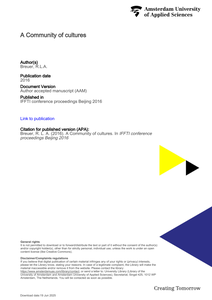This paper discusses the concepts and social dynamics of fashion imitation and custom imitation as put forth by French sociologist Gabriel Tarde (1843-1904). Specifically his 1903 book The Laws of Imitation will be introduced and used to argue that, and examine how, fashion has, since the turn of the century, increasingly become a global custom rather than the exemplary innovative force Tarde associated with fashion. The second part of the paper therefore suggests turning to custom and tradition may be fruitful to revitalise the current state of fashion and can cause new fashions to come into being. The traditional technique used by the people of the Dutch village of Staphorst to decorate the fabrics for their traditional costumes - Staphorster stippling - which is nominated to be inscribed on UNESCO’s list of intangible cultural heritage, is presented as a case study in which it is shown how cultural traditions may unilaterally contribute to ethical, ecological and innovative fashion design. It is furthermore argued that the reciprocal effect of the dynamics between custom and fashion accounts for the preservation of traditional skills and techniques. The text concludes by examining the chances and opportunities as well as the pitfalls one may associate with the proposed dynamic interaction between fashion and tradition.
DOCUMENT

This article traces the emergence of one particular genre of discourse, the genre of "new realism" in the Dutch public debates on multicultural society from the early 1990s till Spring 2002. The focus upon different "genres" implies an interest in the performative power of discourse, i.e. the way in which any discourse, in or by its descriptions of reality, (co)produces that reality. Four distinctive characteristics of "new realism" are detected in three subsequent public debates, culminating in the genre of "hyper-realism", of which the immensely successful and recently murdered politician Pim Fortuyn proved to be the consummate champion. Cet article explique le développement d'un genre particulier de discours, le "nouveau réalisme", au sein du débat public sur la société multiculturelle aux Pays Bas. La période étudidée s'étale du début des années 1990 jusqu'au printemps 2002. L'importance attribuée aux différents "genres" reflète un intérêt pour le pouvoir performatif du discours, notamment la facon dont le discours (co)produit la réalité qu'il décrit. On décèle quatre traits distinctifs du "nouveau réalisme" dans trois débats publics qui débouchent sur le "hyper-réalisme" genre dont Pim Fortuyn, homme politique ayant connu un grand succès et victime récente d'un meurtre,s'était fait le champion attitré.
DOCUMENT

Bij het historisch schatgraven is één van de meest fascinerende vondsten het fenomeen van de veranderende tijdgeest. We kunnen tijdgeest ook ‘sociaal-culturele conjunctuur’ noemen, naar analogie van ‘economische conjunctuur’. Ik hou het op ‘tijdgeest’. Tijdgeest is een moeilijk te pakken en te verklaren verschijnsel, maar het is er niet minder werkzaam door.4 Als we spreken over een veranderde tijdgeest bedoelen we een omslag in collectieve mentaliteit. Die veranderde tijdgeest maakt dat we anders gaan denken, kijken en voelen over allerlei maatschap¬pelijke verschijnselen, en ook over welzijn, over waarden als solidariteit en gelijkheid, rechten en plichten, verantwoordelijk¬heid en maatschappelijk werk. En er spelen vragen als: wie zijn de kwetsbaren, welke taken heeft de overheid en wat moeten burgers zelf doen?
DOCUMENT
